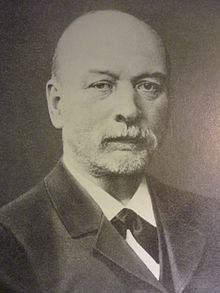Hermann Gruhl
Hermann Gruhl (born April 29, 1834 in Ziegra ; † September 8, 1903 in Brühl ) was a German mining company. He is considered to be one of the founders of industrial lignite mining in the Rhineland .
Life
Gruhl received his training at the Erfurt trade school and then worked in the Central German lignite area , where his older brother owned some lignite concessions at Runtahl in the 1850s , which he consolidated into Werschen-Weißenfelser Braunkohlen AG in 1855 and acquired additional fields. After the early death of his brother, Hermann Gruhl acquired further shares in various lignite fields and began developing the Ottilie and Kupferhammer mines near Oberröblingen in 1868 on behalf of Carl Adolf Riebeck . In 1885 Gruhl was able to increase the briquette production of the briquette factories belonging to the pits by using Schulz's tube dryers , which had been developed on his behalf .
After he and Hermann Bleibtreu had carried out positive tests on briquetting in Oberröblingen with lignite samples from the Brühl area, he took part in his lignite union Bleibtreu in 1874 with 48 (out of 100) kuxes , and the prospectively 1872/73 on the planned Eifel route near Brühl Grubenfelder but which did not go into production. Instead, he and Bleibtreu bought shares and acted as a consultant in the Roddergrube run by Friedrich Eduard Behrens , which pressed the first briquettes in the Rheinische Revier on March 1, 1877 with three presses. After Bleibtreu's death, Gruhl bought his fields near Heide and Kierberg and other fields in Brühl in 1882 . In 1889 Gruhl began to implement his plans and built a briquette factory near Kierberg, which pressed the first briquettes as Gruhlwerk on September 2, 1892 . He had his sons move from the Central German Revier to Brühl. Max took over the commercial management and in 1894 Carl the technical management of the factory. He himself stayed in Halle until 1899. The later Bergrat Carl Gruhl was made an honorary citizen because of his services to the development of the city of Brühl.
His mine holdings in central Germany flowed into the Anhalt coal works . Gruhl had a stately Art Nouveau villa built in Brühl by Leipzig architect Georg Wünschmann in 1899 , which his son Carl then took over.
The city of Brühl honored Hermann Gruhl by naming a street.
Individual evidence
- ↑ Uwe Steinhuber: One Hundred Years of Recultivation in Lusatia ( Memento of the original of January 24, 2016 in the Internet Archive ) Info: The archive link was automatically inserted and not yet checked. Please check the original and archive link according to the instructions and then remove this notice. , Diss. 2005, pp. 70 and 74 PDF
- ^ Walter Buschmann , Norbert Gilson, Barbara Rinn: Brown coal mining in the Rhineland. ed. from LVR and MBV-NRW , 2008, pp. 60 and 297
literature
- Walter Serlo: Men of the mining industry. Berlin 1937.
- Gustav Kloos: Gruhl, Hermann Eduard. In: New German Biography (NDB). Volume 7, Duncker & Humblot, Berlin 1966, ISBN 3-428-00188-5 , p. 208 ( digitized version ).
| personal data | |
|---|---|
| SURNAME | Gruhl, Hermann |
| ALTERNATIVE NAMES | Gruhl, Hermann Eduard |
| BRIEF DESCRIPTION | German mining entrepreneur |
| DATE OF BIRTH | April 29, 1834 |
| PLACE OF BIRTH | Ziegra |
| DATE OF DEATH | September 8, 1903 |
| Place of death | Bruehl (Rhineland) |
